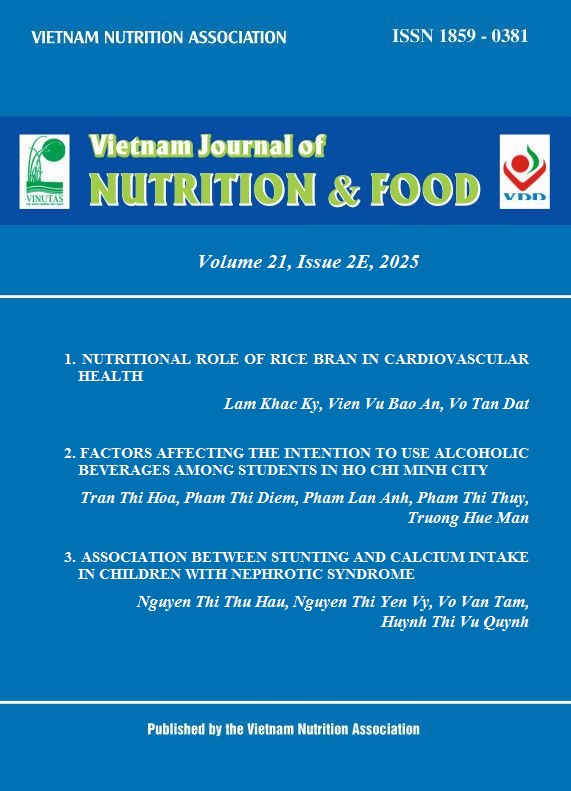EFFECT OF TOTAL SOLUBLE SOLIDS AND pH ON SOME QUALITY PARAMETERS OF FERMENTED BEVERAGE FROM BLUEBERRY (Vaccinium corymbosum L.)
Nội dung chính của bài viết
Tóm tắt
Aims: To investigate the impacts of total soluble solids and pH on the physical and chemical composition, as well as the sensory quality of fermented blueberry beverage (Vaccinium corymbosum L.).
Methods: The study investigated the impact of pH levels (3.8, 4.0, and 4.2) and total soluble solids (18, 20, and 22°Brix) on beverage quality. Sensory quality was evaluated on appearance, color, aroma, and taste of obtained products.
Results: The optimal fermentation occurred at 20°Brix and pH 4.0, yielding a beverage with high alcohol content (4%Vol.), low residual sugar (7.43%), total acidity (0.3%), and anthocyanin content (58.36mg%) after 4 days. Sensory evaluation of this treatment revealed high scores for appearance (4.54), color (4.46), aroma (4.43), and taste (4.66).This resulted in a product characterized by a balanced sweet-and-sour flavor, a vibrant red color, and a moderate ethanol content. Unlike wine, the ethanol level was not overly high, aligning well with current preferences for fermented beverages.
Conclusion: Both pH and total soluble solids significantly affected beverage quality, identifying identifying 20°Brix and pH 4.0 as optimal fermentation conditions for blueberry beverages.
Từ khóa
°Brix, pH, blueberry, 𝘝𝘢𝘤𝘤𝘪𝘯𝘪𝘶𝘮 𝘤𝘰𝘳𝘺𝘮𝘣𝘰𝘴𝘶𝘮 L., fermentation
Chi tiết bài viết
Tài liệu tham khảo
2. Nusrat S, Gerhard M, Tony H et al. Bioinformatic and Molecular Analysis of Satellite Repeat Diversity in Vaccinium Genomes. Genes. 2020;11:527.
3. Wilson M, Rhodes P, Mitchell J et al.. Antilisterial activity of grape juice and grape extracts derived from Vitis vinifera variety Ribier. International journal of food microbiology. 2006;107(3):281-286.
4. Hwang S, Yoon WB, Lee OH et al. Radical scavenging- kinked antioxidant activities of extracts from black chokeberry and blueberry cultivated in Korea. Food Chemistry. 2014;146:71-77.
5. Shi M, Loftus H, McAinch et al..Blueberry is a source of bioactive compounds for the treatment of obesity, type 2 diabetes and chronic inflammation. Journal of Functional Foods. 2017;30:16-29.
6. Tundis R, Tenuta MC, Loizzo MR et al. Vaccinium Species (Ericaceae): From Chemical Composition to Bio-Functional Activities. Appl. Sci.. 2021;11:5655.
7. Mathew B, Silas DM, David E et al. Production of wine from fermentation of Grape (Vitis vinifera) and sweet orange (Citrus seninsis) juice using Saccharomyces cerevisiae isolated from palm wine. International Journal of Current Microbiology and Applied Sciences. 2017;6(1):868-881.
8. Saranraj P, Sivasakthivelan P, Naveen M. Fermentation of fruit wine and its quality analysis: A review. Australian Journal of Science and Technology. 2017;1(2):85-97.
9. Souza PA, Naik PA, Rao SC et al. Fermented fruit juice production using unconventional seasonal fruits through batch fermentation. Journal of Microbiology, Biotechnology and Food Sciences. 2017;6(6):1305-1308.
10.Nga LV. Research on improving the quality of yeast strains and their application in low-alcohol fruit juice fermentation technology [In Vietnamese]. Hanoi Institute of Food Industry. 2004.
11.Pham LD, Fermentation Technology [In Vietnamese]. Viet Nam Education Publishing House. 2010:251.
12.Hanh PTN, Hong NTT et al. Survey on the effects of mixing and yeast ratio to quality of fermented "Sim" - dragon fruit juice [In Vietnamese]. Vietnam Journal of Nutrition & Food. 2022;16(1):35-46.
13.Giusti MM and Wrolstad RE. Characterization and Measurement of Anthocyanins by UV-Visible Spectroscopy. John Wiley & Sons, Inc. 2000.
14.Miller GL. Use of Dinitrosalicylic acid reagent for determination of reducing sugar. Analytical chemistry. 1959;31(3):426-428.
15.Thuong ND and Hang NT. The technology of production and testing of ethyl alcohol [In Vietnamese]. Third edition. Hanoi Science and Technology Publishing House. 2007.
16.TCVN4589:1988 on canned food - method for determining total acid and volatile acid content.
17.TCVN3215-79. Food products sensorial analysis Method by frointingmark. In: State Committee of Science and Technology.
18.Michalska A and Łysiak G. Bioactive compounds of blueberries: Post-harvest factors influencing the nutritional value of products. International journal of molecular sciences. 2015;16(8):18642-18663.
19.Attri BL. Effect of initial sugar concentration on physico-chemical characteristics and sensory quality of cashew apple wine. Natural product radiance. 2009; 8(4):374-379.
20.Hau VC. Making fruit wine at home [In Vietnamese]. Ho Chi Minh City National University Publishing House. 2004.
21.Mi HTN and Tien DTK. Fermentation of pitaya (Selenicereus undatus) using Saccharomyces cerevisiae RV100 [In Vietnamese]. TNU Journal of Science and Technology. 2021;226(14):137-145.
22.Thanh NV, Cuong NP, Toan HT et al. Fermentation of Cau Duc pineapple (Ananas comosus) wine (Hau Giang) using isolated and pure yeast [In Vietnamese]. Can Tho University Journal of Science Part B: Agriculture, Aquaculture and Biotechnology. 2013;27:56-63.
23.Mai TTN. Research on processing fermented soft drinks from acerola fruit (Malpighia glabra L.) [In Vietnamese]. Journal of Agriculture and Development 2020;19(2):99-105.
24.Pham LD. Yeast industry [In Vietnamese]. Science and Technology Publishing House. 2009.
25.Hyo-Nam S, So-Ae J, Hye-Rim P et al. Impact of Various Factors on Color Stability of Fresh Blueberry Juice during Storage. Preventive Nutrition and Food Science. 2018;23(1):46 – 51.
26.Maarit R. Copigmentation reactions and color stability of berry anthocyanins. University of Helsinki, Department of Applied Chemistry and Microbiology. 2005.
27.Wahyuningsih S, Wulandari L, Wartono MW et al. The Effect of pH and Color Stability of Anthocyanin on Food Colorant. IOP Science. 2017;193:1-9.


